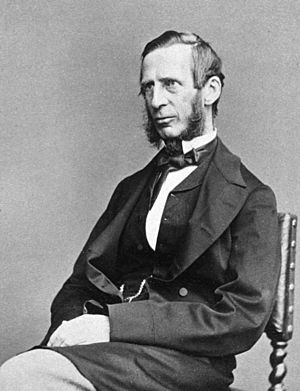George Edward Paget facts for kids
Sir George Edward Paget (born December 22, 1809 – died January 16, 1892) was an important English doctor and a smart university leader. He made big changes in how doctors were trained in the United Kingdom.
Contents
A Doctor's Journey
George was born in Great Yarmouth, England. He was the seventh son in his family. He went to Charterhouse School in 1824, where he studied classic subjects and math. Later, he went to Gonville and Caius College, Cambridge, in 1827. He was very good at math, finishing as one of the top students.
Becoming a Physician
In 1832, George decided to study medicine. He went to St. Bartholomew's Hospital and also studied in Paris. He earned his medical degrees from Cambridge in 1833, 1836, and 1838. In 1839, he became a doctor at Addenbrooke's Hospital, where he worked for 45 years. He also became a member of the Royal College of Physicians.
Changing Medical Education
George Paget lived at Caius College and helped manage its money. He also started his own medical practice. In 1842, he convinced the university to start "bedside examinations" for medical students. This meant students had to examine real patients as part of their tests. These were the first regular clinical exams in the United Kingdom!
Important Roles and Honors
After he got married, George moved out of the college. He became president of the Cambridge Philosophical Society in 1855–56. In 1863, he was chosen to represent the university on the General Council of Medical Education. He was even elected president of this council twice. In 1872, he became the Regius Professor of Physic at Cambridge, which was a very important medical teaching role.
He was honored many times for his work. He became a Fellow of the Royal Society in 1873. In 1885, he was made a Knight Commander of the Order of the Bath, which meant he was called "Sir George." He passed away on January 16, 1892, and was buried in Cambridge.
His Medical Writings
George Paget wrote many articles about interesting medical cases.
- In 1847, he wrote about "Cases of Morbid Rhythmical Movements."
- In 1855, he described a "Case of involuntary Tendency to Fall precipitately forwards."
- In 1860, he wrote about a "Case of Epilepsy with some Uncommon Symptoms," which included strange bursts of laughter.
- He also wrote about a unique case of aphasia (trouble speaking) in a left-handed man.
Studying Old Manuscripts
George Paget was also interested in old medical writings. In 1849, he printed a letter from William Harvey, a famous doctor who discovered how blood circulates. In 1850, he wrote about an unpublished manuscript by Harvey. This helped show that an old manuscript about muscles was truly written by William Harvey.
After he died, his son published four of his lectures. These included talks about alcohol, the causes of typhoid fever, and how mental health can affect the body.
His Family Life
On December 11, 1851, George Paget married Clara Fardell. They had ten children, and seven of them lived to adulthood. Two of his daughters married famous people:
- Clara Maud Paget married Hans Friedrich Gadow, a German scientist who studied birds.
- Rose Elizabeth Paget married Sir J. J. Thomson, a very famous physicist who discovered the electron!


